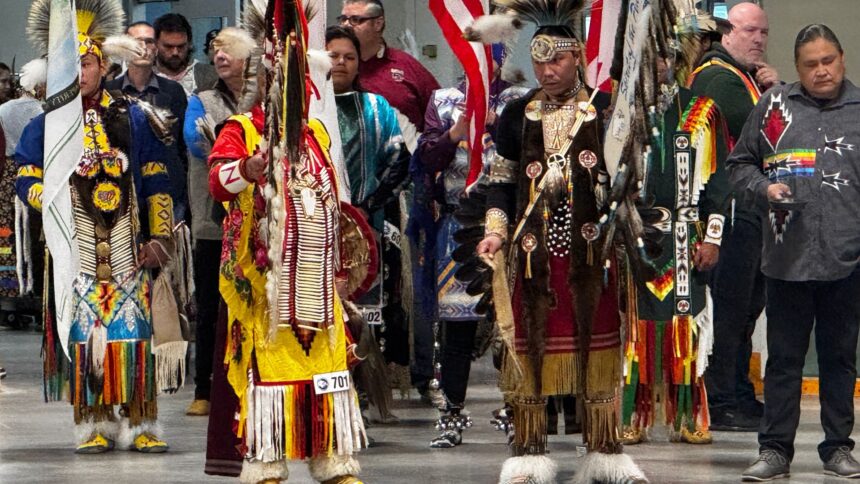In the stillness before movement, a heartbeat of drums rises, shaking loose the settling dust. Children draw close to the arena’s edge, magnetized by the rhythmic pulse that seems to emerge from the earth itself.
It’s the tenth annual Spirit of the Peace Pow Wow, where the fairgrounds outside Fort St. John have transformed into a gathering space that feels both ancient and alive with contemporary energy. Walking among the crowd, I notice the intricate beadwork catching sunlight, each design telling stories generations in the making.
“This isn’t just a performance,” explains Elder Theresa Makadahay, her hands moving expressively as we sit in the shade of her family’s booth. “When we dance, when we drum, we’re communicating with our ancestors. We’re teaching our children who they are.”
The three-day celebration has drawn over 3,000 visitors and more than 250 dancers from across British Columbia, Alberta, and as far as Saskatchewan. For many Indigenous participants, pow wows represent both cultural continuity and evolution – spaces where traditional knowledge passes between generations while creating new connections.
“Ten years ago, we started with maybe 40 dancers and a couple hundred spectators,” says Robert Cardinal, one of the founding organizers and a member of Beaver First Nation. “Now look around you. This is healing in motion.”
That healing takes many forms here. For some, it’s the competitive dancing that showcases extraordinary skill and stamina. For others, it’s the chance to speak their language freely or to introduce children to cultural practices that residential schools once tried to eradicate.
The Canadian Truth and Reconciliation Commission documented how Indigenous ceremonies were systematically banned through much of the 20th century, with practitioners facing imprisonment until the 1950s. That historical context makes gatherings like this one particularly significant, serving as living testimony to cultural resilience.
Nineteen-year-old Jaden Moosewah adjusts his regalia before the men’s fancy dance competition. His outfit features vibrant ribbons and intricate beadwork that took his grandmother and aunts nearly six months to complete.
“My kokum taught me that each movement connects us to something larger,” he says. “When I dance, I’m not just competing – I’m carrying my family’s stories.”
The pow wow’s growing prominence reflects broader shifts in northern B.C., where Indigenous cultural revitalization efforts have expanded significantly over the past decade. Local schools have increasingly incorporated Indigenous knowledge into curricula, while municipal governments and industry partners have begun recognizing the importance of meaningful relationship-building with First Nations.
According to Statistics Canada, Fort St. John and surrounding Peace River Regional District communities have seen Indigenous population growth of approximately 12% since 2016, compared to 9.4% overall population growth during the same period. This demographic shift coincides with greater visibility for Indigenous cultural events.
Elmer Grey Eyes, a traditional knowledge keeper who traveled from Saddle Lake Cree Nation in Alberta, emphasizes how pow wows create space for urban Indigenous community members to maintain connections to their heritage.
“Many of our people now live in cities, away from their traditional territories,” he explains while preparing cedar bundles for a blessing ceremony. “These gatherings are where young people especially can remember who they are, where they come from.”
The economic impact of the event is also significant. Vendor stalls line the perimeter, offering everything from traditional foods like bannock and stew to handcrafted jewelry, clothing, and art. Local hotels report being fully booked for the weekend, while restaurants and shops in Fort St. John see increased traffic.
“This is Indigenous economic development in action,” explains Sarah Paquette, who coordinates the artisan marketplace. “Many of these vendors support their families through traditional arts, and the pow wow circuit provides crucial income opportunities.”
The growing attendance of non-Indigenous visitors represents another important dimension. Families from across the Peace Region arrive curious and often leave transformed by the experience.
“I’ve been bringing my kids for three years now,” shares Christine Levesque, a Fort St. John resident. “It’s opened conversations about history that weren’t happening before, and my daughter has developed such respect for the dancers and their stories.”
As evening approaches, the Grand Entry begins – a spectacular procession of dancers entering the arena by category, led by veterans carrying flags and eagle staffs. The announcer reminds spectators that certain moments require standing out of respect, and explains the significance of each dance style.
“Education happens naturally here,” notes Makadahay. “People learn by witnessing, by asking questions, by being present. That’s how understanding grows.”
When darkness falls, the dancing continues under floodlights. The younger children have been watching intently all day, and now many join impromptu dances around the periphery, mimicking the movements they’ve observed. Their parents watch with evident pride.
“That’s how I learned,” says Cardinal, nodding toward a small boy carefully placing his feet in rhythm with the drums. “Not from books or classes, but from watching my uncles, my cousins. Now my grandchildren are learning the same way.”
As the pow wow continues through the weekend, it embodies something more complex than simple entertainment or cultural display. It represents community resilience, economic opportunity, and the ongoing work of reconciliation – not through performative gestures, but through genuine cultural exchange and recognition.
The Spirit of the Peace Pow Wow has grown from a modest gathering into a cultural landmark for northern B.C., creating ripples that extend far beyond the dance arena. For three days each summer, it transforms a fairground into sacred space where past and future converse through the universal language of dance, music, and shared humanity.
Walking back to my car under the northern sky, I carry with me the Elder’s words from earlier: “A pow wow isn’t just something you watch – it’s something you feel. And once you’ve felt it, you carry that spirit with you.”






